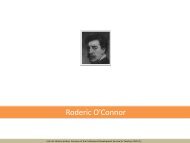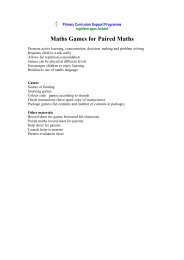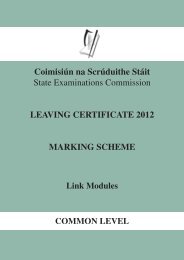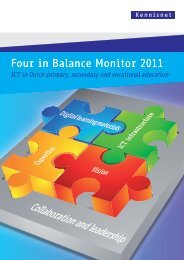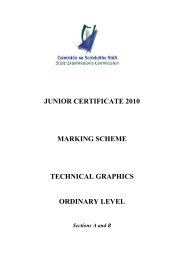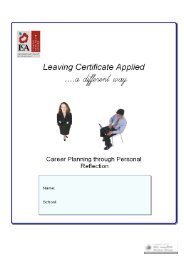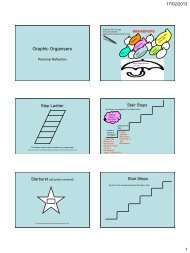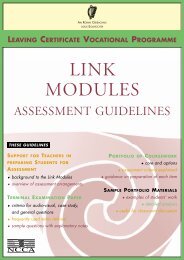Office Administration and Customer Care Module Descriptor - PDST
Office Administration and Customer Care Module Descriptor - PDST
Office Administration and Customer Care Module Descriptor - PDST
- No tags were found...
You also want an ePaper? Increase the reach of your titles
YUMPU automatically turns print PDFs into web optimized ePapers that Google loves.
<strong>Office</strong> <strong>Administration</strong><strong>and</strong> <strong>Customer</strong> <strong>Care</strong>
TOPICS IN COMMONOFFICEADMINISTRATION& CUSTOMER CAREAdvertisingConsumer Education<strong>Customer</strong> <strong>Care</strong>Interpersonal SkillsLetter WritingPaymentsRecord KeepingSafetyTelephone TechniquesWorker Rights &ResponsibilitiesCOURSEVocational Preparation & GuidanceEnglish & CommunicationsMathematical ApplicationsSocial EducationActive Leisure StudiesAgriculture/HorticultureChildcare/Community <strong>Care</strong>Graphics & Construction StudiesCraft & DesignEngineeringHair & BeautyHotel Catering & TourismInformation & Communication TechnologyTechnologyGaeilgeArts - Visual-Drama-Music & DanceIntroduction to Information & Communications TechnologyLeisure & RecreationModern LanguageReligious EducationScienceSign Language
LEAVING CERTIFICATE APPLIEDVOCATIONAL EDUCATIONOFFICE ADMINISTRATIONAND CUSTOMER CARE
OFFICE ADMINISTRATION AND CUSTOMER CARE
OFFICE ADMINISTRATION AND CUSTOMER CARECONTENTSINTRODUCTION 3Rationale 3Number <strong>and</strong> Sequence of <strong>Module</strong>s 4Description of <strong>Module</strong>s 4General Recommendations 5MODULE 1RETAILING & SELLING 7Purpose 8Prerequisites 8Aims 8Units 8Unit 1: The Retail Organisation 9Unit 2: Selling Techniques 11Unit 3: <strong>Customer</strong> relations 12Resources 13Key Assignments 14MODULE 2OFFICE ASSISTANT 15Purpose 16Prerequisites 16Aims 16Units 16Unit 1: Underst<strong>and</strong>ing the role <strong>and</strong> function of the office 17Unit 2: Filing 19Unit 3: Communications <strong>and</strong> the <strong>Office</strong> 20Resources 21Key Assignments 221
OFFICE ADMINISTRATION AND CUSTOMER CAREMODULE 3OFFICE PRACTICE 23Purpose 24Prerequisites 24Aims 24Units 24Unit 1: Recording information 25Unit 2: Petty cash 26Unit 3: Personal <strong>and</strong> interpersonal skills 27Unit 4: Health <strong>and</strong> safety 28Key Assignments 29MODULE 4RETAILING & THE CONSUMER 31Purpose 32Prerequisites 32Aims 32Units 32Unit 1: Consumer <strong>and</strong> the law 33Unit 2: Calculations <strong>and</strong> payments 34Unit 3: Advertising <strong>and</strong> display 35Unit 4: Being an employee 36Resources 37Key Assignments 382
OFFICE ADMINISTRATION AND CUSTOMER CAREI NTRODUCTIONRATIONALEThe <strong>Office</strong> <strong>Administration</strong> <strong>and</strong> <strong>Customer</strong> <strong>Care</strong> course is designed todevelop in students, skills <strong>and</strong> competencies of a broad personal <strong>and</strong>vocational nature. This course should provide as many opportunities aspossible for practical activities <strong>and</strong> to this end it is recommended that apractice office is set up in the classroom.3
OFFICE ADMINISTRATION AND CUSTOMER CARENUMBER AND SEQUENCE OF MODULESThe order of completion of these modules is at the discretion of theteacher/school, however it is recommended that <strong>Module</strong> 2: <strong>Office</strong>Assistant be completed before <strong>Module</strong> 3: <strong>Office</strong> Practice.The course consists of four modules1. Retailing <strong>and</strong> Selling2. <strong>Office</strong> Assistant3. <strong>Office</strong> Practice4. Retailing <strong>and</strong> the ConsumerDESCRIPTION OF MODULESMODULE 1: RETAILING AND SELLINGThis module is designed to introduce students to the structure of retailorganisations. It looks at how changes in lifestyle have influencedretailing in Irel<strong>and</strong>. It prepares students to engage in good sellingpractices <strong>and</strong> introduces the student to the personal skills <strong>and</strong> qualitiesneeded by a salesperson.MODULE 2: OFFICE ASSISTANTThis module is intended to introduce the student to the practical skillsneeded in an office. It is necessary to have access to certain officeequipment to deliver the module. It also emphasises the use <strong>and</strong>practice of good communication techniques.MODULE 3: OFFICE PRACTICEThis module is designed to help students to record informationaccurately <strong>and</strong> to develop good practice in relation to simple officeaccounts. It also promotes good practice in relation to health <strong>and</strong> safetyin the office environment.4
OFFICE ADMINISTRATION AND CUSTOMER CAREMODULE 4: RETAILING AND THE CONSUMERThis module is designed to allow the student to become proficient atdealing with the customer <strong>and</strong> to become familiar with the legal rightsof the customer. It builds on the skills acquired in the Retailing <strong>and</strong>Selling module <strong>and</strong> also introduces the concept of industrial relations.GENERAL RECOMMENDATIONSThe Teacher Guidelines provide suggestions in relation to classroompractice. The guidelines are not prescriptive. There is scope forteachers to exercise their own professional judgement based on theinterests, needs <strong>and</strong> abilities of the group. However, it is essentialthat the fundamental principles of the Leaving Certificate Applied beupheld. Teachers are therefore required to adopt a methodology thatis student centred, activity based <strong>and</strong> affirming. The course willrequire 4 class periods of approx. 40 minutes per week. To facilitateout-of-school activity it is recommended that these periods aretimetabled as double periods.5
OFFICE ADMINISTRATION AND CUSTOMER CARE6
OFFICE ADMINISTRATION AND CUSTOMER CAREMODULE 1RETAILING & SELLING7
OFFICE ADMINISTRATION AND CUSTOMER CARE • RETAILING & SELLINGMODULE 1:RETAILING & SELLINGPURPOSEThe purpose of this module is to familiarise the students with therole of the retailer in the chain of distribution <strong>and</strong> to allow thestudents to develop an underst<strong>and</strong>ing of the importance of theselling situation.PREREQUISITESNone.AIMSThis module aims:• to develop students’ underst<strong>and</strong>ing of the features of a retailorganisation from an outsiders point of view• to help students to appreciate the importance of conducting asale in an appropriate manner• to develop students’ appreciation of the importance of goodinterpersonal skills when dealing with customers.UNITSUnit 1:Unit 2:Unit 3:The Retail OrganisationSelling Techniques<strong>Customer</strong> Relations8
OFFICE ADMINISTRATION AND CUSTOMER CARE • RETAILING & SELLING • THE RETAIL ORGANISATIONUnit 1: The retail organisationLEARNING OUTCOMESTEACHER GUIDELINESThe student should be able to:1. identify different types ofretail organisations2. list the members of the chainof distribution3. underst<strong>and</strong> the role of the wholesaler4. underst<strong>and</strong> the role of the retailer5. identify characteristics/methods ofoperation of different retail outlets(sole trader, multiple store, departmentstore, superstores, hypermarkets <strong>and</strong>co-operatives) Brainstorm in class. Refer to workexperience <strong>and</strong> part-time employment. Manufacturer, wholesaler, retailer,consumer, seek examples of when thischain differs, e.g. manufacturer toconsumer, mail order etc. Role of the wholesaler to both theretailer <strong>and</strong> the manufacturer. Visit alocal cash <strong>and</strong> carry or other wholesaleoutlet to look at stocktaking methods,storage techniques, use of bar coding etc. Role of the retailer to both thewholesaler <strong>and</strong> the consumer.Visit various retail outlets, drawplans of the various layouts, interviewstaff. This can be a specially arrangedvisit or linked with work experienceor part-time work. Carry out a survey of different typesof retail outlets to check theirmethods of selling.9
OFFICE ADMINISTRATION AND CUSTOMER CARE • RETAILING & SELLING • THE RETAIL ORGANISATIONUnit 1: The retail organisation (Continued)LEARNING OUTCOMESTEACHER GUIDELINES6. identify how changes in lifestyle haveinfluenced retailing6. underst<strong>and</strong> the differences between themethods of non-shop retailing (i.e.mail order, TV selling, newspapers,parties, internet selling)8. explain modern developmentsin retailing (i.e. Franchising,Discount Stores). Brainstorm lifestyle changes e.g. greaterdem<strong>and</strong> for convenience food, low fatfood, greater teenage spending etc. Get students to collect mail orderbrochures, catalogues from retail parties(Tupperware, etc.) video shoppingchannels. Look up the internet on someshopping sites. Hold class discussion onany experiences of using these methodsof shopping. Examine newspaper sale advertisements<strong>and</strong> pick out the different retailtypes. Identify franchise operationsin the local area.10
OFFICE ADMINISTRATION AND CUSTOMER CARE • RETAILING & SELLING • SELLING TECHNIQUESUnit 2: Selling techniquesLEARNING OUTCOMESTEACHER GUIDELINESThe Student should be able to:1. underst<strong>and</strong> the functions ofthe salesperson2. practise the personal qualities<strong>and</strong> skills needed by the salesperson3. distinguish between sellingsituations (self-service, self selection,<strong>and</strong> personal service). Functions include:to sell, care for stock, take payments, bevigilant, deal with cash complaints. Referto experiences from work experience<strong>and</strong> part-time work. Qualities include:ability to listen, pleasant/outgoing,clarity of speech, enthusiasm.Link with the English <strong>and</strong>Communication teacher who willbe dealing with many of these qualities. Role-play the different situations orget students to recall the differentsituations from work experienceor part-time work.11
OFFICE ADMINISTRATION AND CUSTOMER CARE • RETAILING & SELLING • CUSTOMER RELATIONSUnit 3: <strong>Customer</strong> relationsLEARNING OUTCOMESTEACHER GUIDELINESThe Student should be able to:1. underst<strong>and</strong> why the customer isalways important2. greet customers in anappropriate manner3. recognise when it is appropriatethat the customer should beallowed to browse4. demonstrate the importance of productknowledge when sellingi.e. functions, special features,materials, origins5. explain the means of buildingcustomer loyalty6. maintain courtesy throughout a sale7. deal with customer services suchas returns. Get students to recall "good"<strong>and</strong> "bad" shopping experiences. Role-play different situations. Brainstorm situations where studentswere not allowed to browse <strong>and</strong>where service was overpowering. Role-play selling situations usingdifferent products or services. Discuss special promotions, sales,policy on returns, alterations,after-sale service etc. Role-play selling situations. Role-play situations. Get examplesof credit notes. Discuss the legalposition on returns.12
OFFICE ADMINISTRATION AND CUSTOMER CARE • RETAILING & SELLINGRESOURCESRGDATA H<strong>and</strong>book, by Michael Campbell. A folder of A4 sheets giving allthe information the retailer needs to know on the law etc. Cost £49 approxCrowning the <strong>Customer</strong>, by Feargal QuinnSelling Techniques for Supermarkets – Consumer Choice.Retailing, Irish Business Manuals, available in WaterstonesIrish Times, Business 2000 – Case Studies.13
KEY ASSIGNMENTSMODULE 1: RETAILING AND SELLINGCHECKLISTI have visited a retailer or wholesaler as part of a classexercise <strong>and</strong> have drawn up a short report on that visitI have listed five different types of retailers <strong>and</strong> explainedthree points on how they operateI have looked up the internet to examineon line shoppingI have completed a short survey on howpeople shop in my own area.14
OFFICE ADMINISTRATION AND CUSTOMER CAREMODULE 2OFFICE ASSISTANT15
OFFICE ADMINISTRATION AND CUSTOMER CARE • OFFICE ASSISTANTMODULE 2:OFFICE ASSISTANTPURPOSETo introduce the student to basic office tasks thus enabling thestudent to be able to perform simple functions. It also ensuresthat the learner underst<strong>and</strong>s the methods of communicationavailable in the office.PREREQUISITESNone.AIMSThis module aims:• to develop students’ underst<strong>and</strong>ing of simple office functions• to provide students with the opportunity to acquire simplepractical skills necessary to perform some routine office duties• to develop students’ appreciation of the importance ofcommunication in any work environment.UNITSUnit 1:Unit 2:Unit 3:Underst<strong>and</strong>ing the role <strong>and</strong> function of the officeFilingCommunications <strong>and</strong> the <strong>Office</strong>.16
OFFICE ADMINISTRATION AND CUSTOMER CARE • OFFICE ASSISTANT • UNDERSTANDING THE ROLE AND FUNCTION OF THE OFFICEUnit 1: Underst<strong>and</strong>ing the role <strong>and</strong> function of the officeLEARNING OUTCOMESTEACHER GUIDELINESThe Student should be able to:1. outline the different types ofoffice layouts2. identify the functions of an officein relation to information(e.g. receipt, collection, recording,sorting, classification, storage,communication <strong>and</strong> protection)3. list the different departments foundwithin an office <strong>and</strong> identify the mainroles of each of these departments(e.g. wages, accounts, mail, purchasing)4. present an organisational chart5. demonstrate the use of common officeequipment (e.g. photocopier, calculator,stapler, guillotine, telephone, fax,filing cabinet) Get students to draw different typesof layout. Encourage students toobserve different layouts whileon work experience. Business textbooks can be used.Encourage students to be aware ofthe office functions while on workexperience even when the student is notworking in an office environment. The student should be aware of howeach of these functions is carried out.Students can collect employmentadvertisements from newspapers,the Internet etc. to check qualifications<strong>and</strong> training necessary for such jobs. Any form of chart is acceptable. The teacher needs to ensure that he/shehas access to the listed equipment.These can be demonstrated <strong>and</strong> practisedthroughout the module. Students shouldhave obtained a competency in allof these by the end of the module.The student can also be encouragedto observe <strong>and</strong> use, if appropriate,various office equipment while onwork experience.17
OFFICE ADMINISTRATION AND CUSTOMER CARE • OFFICE ASSISTANT • UNDERSTANDING THE ROLE AND FUNCTION OF THE OFFICEUnit 1: Underst<strong>and</strong>ing the role <strong>and</strong> function of the office (Continued)LEARNING OUTCOMESTEACHER GUIDELINES6. use common items of office stationery<strong>and</strong> supplies (e.g. headed paper,envelopes, memos, diaries, paper clips,correction fluid) The teacher should ensure that there is asupply of the listed items available forthe students use.7. use a range of st<strong>and</strong>ard paper <strong>and</strong>envelope sizes8. write a business letter <strong>and</strong> addressan envelope9. identify the uses of common genericcomputer applications packages (wordprocessing, data base, spreadsheets). Encourage students to use wizards onword processing packages to checkdifferent layouts. Get students to collectsamples of letterheads <strong>and</strong> envelopeswhile on work experience. The operation of the packages is notrequired here as this will be covered inthe ICT module. However use of thesepackages should be encouragedwherever possible.18
OFFICE ADMINISTRATION AND CUSTOMER CARE • OFFICE ASSISTANT • FILINGUnit 2: FilingLEARNING OUTCOMESTEACHER GUIDELINESThe student should be able to:1. explain the importance of anefficient filing system2. list the essential elements of afiling system Having access to a filing cabinetfor class material <strong>and</strong> thus allowingthe students to maintain it canachieve this.3. use a variety of different methodsof filing4. demonstrate the use of these methodseffectively.19
OFFICE ADMINISTRATION AND CUSTOMER CARE • OFFICE ASSISTANT • COMMUNICATIONS AND THE OFFICEUnit 3: Communications <strong>and</strong> the officeLEARNING OUTCOMESTEACHER GUIDELINESThe student should be able to:1. use some of the means of transmittinginformation (e.g. telephone, fax,electronic mail)2. identify circumstances when thetelephone, fax, modem, electronic mailare used3. demonstrate an ability to use correcttelephone techniques includingreceiving, recording, dealing with iratecustomers, making calls for thirdparties <strong>and</strong> receiving messages forthird parties4. identify the common methods ofreproducing documents in the office(e.g. photocopiers, printers)5. demonstrate an ability to use thephotocopier to make double sidedcopies of multiple page documents,to enlarge <strong>and</strong> reduce documentson a photocopier. Access to a photocopier <strong>and</strong> telephone<strong>and</strong> other equipment is needed tocomplete this unit. A class visit to an office would bea useful introduction to this unit. Role-play to start then use actual phonesto make calls. A telephone trainingsystem can also be used. Access to the school photocopieris necessary or other alternativearrangements e.g. suitablework experience.20
OFFICE ADMINISTRATION AND CUSTOMER CARE • OFFICE ASSISTANTRESOURCESIn Business, by Stack/McGeady. Published by The Education Company21
KEY ASSIGNMENTSMODULE 2: OFFICE ASSISTANTCHECKLISTI visited an office <strong>and</strong> explained the maintype of work done thereI practised different methods of filingI have presented a h<strong>and</strong>-written or word-processedbusiness letter <strong>and</strong> envelope <strong>and</strong> I listed 5 items of officestationery/supplies <strong>and</strong> what they are used forI used the photocopier, calculator, stapler, guillotine, filingcabinet, telephone <strong>and</strong> fax machine <strong>and</strong> used e-mail.22
OFFICE ADMINISTRATION AND CUSTOMER CAREMODULE 3OFFICE PRACTICE23
OFFICE ADMINISTRATION AND CUSTOMER CARE • OFFICE PRACTICEMODULE 3:OFFICE PRACTICEPURPOSEThis module has been developed to enable the student to becomefamiliar with the office environment. It provides experience inroutine office tasks <strong>and</strong> ensures that the student fullyunderst<strong>and</strong>s the importance of personal grooming.PREREQUISITES<strong>Office</strong> Assistant <strong>Module</strong>.AIMSThis module aims:• to develop students’ underst<strong>and</strong>ing of the importance of accuraterecording of information in the office• give students the opportunity to acquire practical skills necessary tocarry out routine office functions• to develop students’ appreciation of the importance of workingin a safe environment• to promote the development of good interpersonal skills withclass/work colleagues.UNITSUnit 1:Unit 2:Unit 3:Recording informationPetty cashPersonal <strong>and</strong> interpersonal skillsUnit 4:Health <strong>and</strong> safety.24
OFFICE ADMINISTRATION AND CUSTOMER CARE • OFFICE PRACTICE • RECORDING INFORMATIONUnit 1: Recording InformationLEARNING OUTCOMESTEACHER GUIDELINESThe Student should be able to:1. sort incoming mail2. record visitors to the organisation3. record receipts <strong>and</strong> payments(with 4 analysis columns)4. record outgoing mail5. record verbal messages correctly. The student can be encouragedto do this in the school office<strong>and</strong> in small groups. The student should be able to keepa list showing date, name <strong>and</strong>purpose of the visit of the visitor. Receipts <strong>and</strong> payments (cash <strong>and</strong> bank)can be recorded in a two-sided cashbookor by means of a receipts page <strong>and</strong> apayments page. (Four analysis columns)Closing balance must be calculated. The students should know how to writeup a Postage Book showing date,addresses, item cost <strong>and</strong> specialfeatures if any. Any type of memo for recording phonemessages <strong>and</strong> personal caller messagesis acceptable.25
OFFICE ADMINISTRATION AND CUSTOMER CARE • OFFICE PRACTICE • PETTY CASHUnit 2: Petty cashLEARNING OUTCOMESTEACHER GUIDELINESThe student should be able to:1. explain the purpose of petty cash2. record transactions in a4 columnar petty cash book3. explain the imprest systemof petty cash. As well as practising the correctrecording procedure for petty cashstudents can be encouraged to use pettycash books for recording incoming <strong>and</strong>outgoing cash during their enterprisemodule or any other activities organisedby them as a group during the year.26
OFFICE ADMINISTRATION AND CUSTOMER CARE • OFFICE PRACTICE • PERSONAL AND INTERPERSONAL SKILLSUnit 3: Personal <strong>and</strong> interpersonal skillsLEARNING OUTCOMESTEACHER GUIDELINESThe student should be able to:1. work as part of a team2. listen to <strong>and</strong> follow instructions3. work under supervision4. formulate questions in order to gatherinformation Liaise with the enterprise teacherto achieve this learning outcome.This can also be achieved throughstudents organising an event orouting for the class. Following instructions accurately <strong>and</strong>working under supervision should beencouraged throughout the module <strong>and</strong>also linked to work experience. Students can prepare questionsfor a simple survey.5. pay attention to detail in the executionof all office duties6. appreciate the importance of goodpersonal hygiene/grooming7. appreciate the importance oftimekeeping8. appreciate the importance ofmaintaining a good attitude to work. A visitor to the classroom to demonstrategood grooming, make-up, hygiene,dress, correct diet <strong>and</strong> exercisecan be very effective. Brainstorm on timekeeping methodsencountered by students while on workexperience or part-time job. Link with the vocational preparationteacher <strong>and</strong> also brainstorm onexperiences of the students while onwork experience <strong>and</strong> part-time jobs.27
OFFICE ADMINISTRATION AND CUSTOMER CARE • OFFICE PRACTICE • HEALTH AND SAFETYUnit 4: Health <strong>and</strong> SafetyLEARNING OUTCOMESTEACHER GUIDELINESThe student should be able to:1. use office equipment safely (e.g.guillotine, electrical equipment,lifting, rest periods)2. recognise <strong>and</strong> avoid potential hazardsin the office3. underst<strong>and</strong> the main provisions of theHealth <strong>and</strong> Safety at Work Act4. underst<strong>and</strong> the importance offire regulations. The learning outcomes in this unit canbe achieved by having a visit from ahealth <strong>and</strong> safety officer to the classroomor a class visit to a suitable industry. Students should be encouraged to payparticular attention to Health <strong>and</strong> Safetywhile on work experience. Leaflets can be obtained from the Health<strong>and</strong> Safety Authority, Dublin. LeavingCertificate Business textbooks alsocontain the main provisions of theHealth <strong>and</strong> Safety at Work Act. A visit from a fire officer who could helpstudents prepare for a fire drill.28
KEY ASSIGNMENTSMODULE 3: OFFICE PRACTICECHECKLISTI have completed a Receipts <strong>and</strong> Payments Book showinga closing balance for cash <strong>and</strong> bank, manually orby computerI have written up a Petty Cash Book using theImprest System with four analysis columns,manually or on computerI have written up a PostageBook correctlyI have taken part in a Health <strong>and</strong> Safety exercise<strong>and</strong> compiled a short report on the activity.(This exercise could be a survey of Health <strong>and</strong> Safetyin a particular room in the school or exit points or afire drill or report on a visit of a health <strong>and</strong> safetyofficer to the classroom or writing a safety statementfor their own classroom or any other such activity).29
OFFICE ADMINISTRATION AND CUSTOMER CARE30
OFFICE ADMINISTRATION AND CUSTOMER CAREMODULE 4RETAILING & THE CONSUMER31
OFFICE ADMINISTRATION AND CUSTOMER CARE • RETAILING & THE CONSUMERMODULE 4:RETAILING & THE CONSUMERPURPOSEThis module prepares the students for employment in a retailorganisation. It allows the student to appreciate the importanceof consumer loyalty to the retailer <strong>and</strong> to underst<strong>and</strong> theresponsibilities of the retailer to his/her employees.PREREQUISITESRetailing <strong>and</strong> Selling module.AIMSThis module aims:• to develop students’ appreciation of the importance of goodpresentation <strong>and</strong> merch<strong>and</strong>ising skills• to promote students’ recognition of the responsibilities ofthe retailer to the consumer• to develop students’ awareness of the legal rights of the employee• to help students learn how to h<strong>and</strong>le payments in anappropriate manner.UNITSUnit 1:Unit 2:Unit 3:Unit 4:Consumer <strong>and</strong> the lawCalculations <strong>and</strong> paymentsAdvertising <strong>and</strong> displayBeing an employee32
OFFICE ADMINISTRATION AND CUSTOMER CARE • RETAILING & THE CONSUMER • CONSUMER AND THE LAWUnit 1: Consumer <strong>and</strong> the lawLEARNING OUTCOMESTEACHER GUIDELINESThe student should be able to:1. define a consumer2. differentiate between goods<strong>and</strong> services3. explain what is meant by proofof purchase <strong>and</strong> prepare a receipt4. explain the importance of keepinga proof of purchase5. outline the legal responsibilities of aretailer towards his/her customer undercurrent law (i.e. the Sale of Goods <strong>and</strong>Supply of Services Act 1980)6. deal effectively with customercomplaints in accordance withhouse policy7. check policies on delivery8. outline the retailer’s responsibilitiesunder the Consumer InformationAct 1978. Brainstorm the differentsituations when the studentshave been consumers. Get students to collect examples ofdifferent types of receipts. Encourage students to issue receiptswhen running their enterprise. Get students to write to the ConsumerAssociation of Irel<strong>and</strong> for thisinformation. This information is alsoavailable on the internet. Research different policies oncomplaints, returns etc. role-playdifferent situations as a consumer. Find out if delivery is free or chargedon various items. Information available in LeavingCertificate Business textbooks.33
OFFICE ADMINISTRATION AND CUSTOMER CARE • RETAILING & THE CONSUMER • CALCULATIONS AND PAYMENTSUnit 2: Calculations <strong>and</strong> paymentsLEARNING OUTCOMESTEACHER GUIDELINESThe student should be able to:1. calculate VAT inclusive <strong>and</strong> VATexclusive pricesSome of these procedures will also bepracticed in Mathematical Applications.2. calculate cash <strong>and</strong> trade discounts<strong>and</strong> allowances3. underst<strong>and</strong> the difference betweenmark-up <strong>and</strong> margin4. calculate mark-up5. demonstrate an ability to followproper cash register procedures6. complete bank lodgement forms7. sort cash for lodgement8. prepare invoice, credit note, debitnote, cheque <strong>and</strong> receipt9. use the correct procedures whenh<strong>and</strong>ling cash transactions10. deal with refunds, voids, vouchers,credit notes, cash collections11. recognise situations <strong>and</strong> follow correctprocedures when the supervisor’ssignature is required A cash register is required for this unit.If the school does not have one availablethe teacher could arrange a visit to alocal retailer so that the use of a cashregister can be practised. Some studentsmay be able to practise this during workexperience or in part-time jobs. Lodgement forms available from banks,building societies etc. These learning outcomes are bestachieved by practising in actualsituations where possible. Opportunitieswithin the school include the enterprisemodule, organisation of events,collections for charity or fundraising etc.Outside of school students should beencouraged to observe or practise ifpossible during work experience orpart-time work.12. follow the correct procedures forvalidating cheques13. follow the correct procedures for creditcard, cheque card, laser card <strong>and</strong> debitcard transactions.34
OFFICE ADMINISTRATION AND CUSTOMER CARE • RETAILING & THE CONSUMER • ADVERTISING AND DISPLAYUnit 3: Advertising <strong>and</strong> displayLEARNING OUTCOMESTEACHER GUIDELINESThe student should be able to:1. distinguish between different typesof display2. identify the specific areas withina retail unit for display3. recognise effective merch<strong>and</strong>ising <strong>and</strong>methods of promotion within a store4. underst<strong>and</strong> the importance of goodatmosphere <strong>and</strong> layout in theretail organisation5. create examples of the differenttypes of promotion (advertising)in retailing, the media, outdooradvertising, transport advertising, pointof sale materials, in-store promotions. Organise a visit to various types of retailoutlet <strong>and</strong> observe <strong>and</strong> sketch differenttypes of display. Observe how goods are grouped <strong>and</strong>the sequence of displays etc. Gather examples of the type of musicplayed in shops, the type of atmospheree.g. through furnishings, flooring etc. Design a group collage or tape or otherform of advertisement for a good orservice. Link with the enterpriseteacher to prepare a st<strong>and</strong> for theenterprise trade fair. Prepare a displayin the school for Christmas orSt. Patrick’s Day or Easter.35
OFFICE ADMINISTRATION AND CUSTOMER CARE • RETAILING & THE CONSUMER • BEING AN EMPLOYEEUnit 4: Being an employeeLEARNING OUTCOMESTEACHER GUIDELINESThe student should be able to:1. complete an application formfor employment2. identify the basic legal rightsof an employee3. identify the responsibilitiesof an employee4. identify the role of industrial relationspractices in the workplace e.g. tradeunions, workers councils etc.5. underst<strong>and</strong> the importance ofa contract of employment6. explain the purpose of keepingemployee records. Link with the VocationalPreparation teacher. Information on rights <strong>and</strong> responsibilitiesof an employee available from tradeunions <strong>and</strong> in Leaving Certificatebusiness textbooks. Arrange a visit from a trade unionrepresentative to the class. Encourage students to seek examplesof contracts of employment while onwork experience or examples fromtheir own part-time jobs. Remindstudents that contracts of employmentare not always in writing. The function of basic records such astime sheets, holiday sheets, medicalcertificates, disciplinary recordsare what is required here.36
OFFICE ADMINISTRATION AND CUSTOMER CARE • RETAILING & THE CONSUMERRESOURCESSTUDENT TEXTRetail Distribution, by Dale <strong>and</strong> Banfield. Pitman publicationTEACHER RESOURCESRGDATA H<strong>and</strong>book, by Michael Campbell. A folder of A4 sheetsgiving all the information the retailer needs to know on the law etc.Cost £49 approxCrowning the <strong>Customer</strong>, by Feargal QuinnUnderst<strong>and</strong>ing Trade Unions, yesterday <strong>and</strong> today,O’Brien Educational Press, DublinLabour of Love, video from ICTU, 16 Raglan Road, Dublin 4SOME USEFUL ADDRESSESConsumer Association of Irel<strong>and</strong>Health <strong>and</strong> Safety AuthorityEuro Changeover Board of Irel<strong>and</strong>www.consumerassociation.iewww.has.iewww.irlgov.ie/ecbi-euro37
KEY ASSIGNMENTSMODULE 4: RETAILING & THE CONSUMERCHECKLISTI have completed book keeping exercises in which Icalculated cost price, unit cost, mark up <strong>and</strong> selling priceI have prepared a window display or product displayas part of a teamI have completed a short report on a visit to/visitfrom a union representativeI have drawn up a contract of employment <strong>and</strong> I haveidentified the rights of the employee in it.38
Published by The Stationery <strong>Office</strong>To be purchased directly from:Government Publications Sales <strong>Office</strong>,Sun Alliance House,Molesworth Street, Dublin 2.Or by mail order from:Government Publications, Postal Trade Section,4-5 Harcourt Road, Dublin 2.Tel: 01-647 6834/5 Fax: 01-475 2760Or through any bookseller.Price: £1.50This programme has been funded by the European Social FundDesigned by: Langley Freeman Design Group Limited© 2000 Government of Irel<strong>and</strong>



